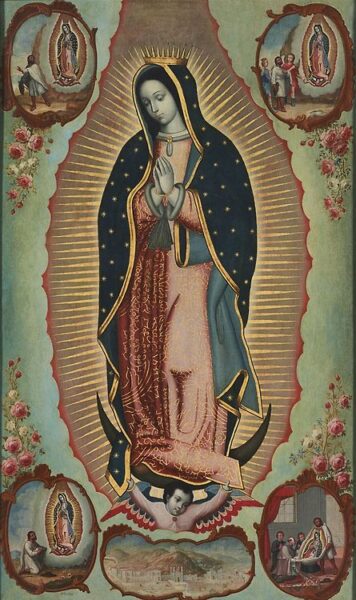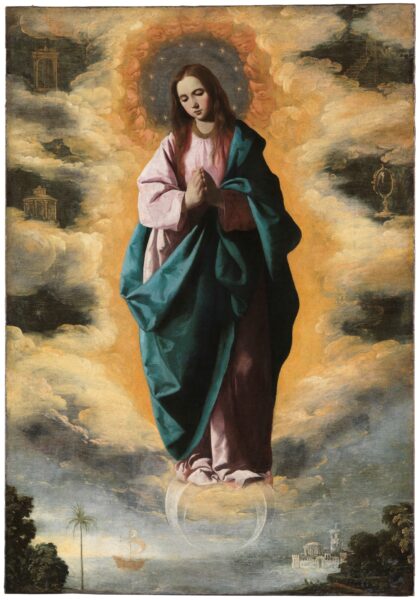 I wrote a blog post about the O Antiphons in 2019, and I loved picking out the image to illustrate each one. So I have decided to post on the O Antiphons again, in order to highlight additional images and to explore the scriptural roots of the meaningful word images. If you aren’t familiar with the O Antiphons or need a refresher, please check out my 2019 blog post here.
I wrote a blog post about the O Antiphons in 2019, and I loved picking out the image to illustrate each one. So I have decided to post on the O Antiphons again, in order to highlight additional images and to explore the scriptural roots of the meaningful word images. If you aren’t familiar with the O Antiphons or need a refresher, please check out my 2019 blog post here.
So yesterday was the end of the traditional seven days for praying the O Antiphons. And yet, here is the bonus eighth O Antiphon that we can approach to complete the circle. Oliver Treanor writes, “[T]he completed circle that the antiphons announce is not something static. It is a spiraling maelstrom of love that draws to its inner self all [hu]mankind, all history, the very cosmos itself.”
It is certainly worth reciting these final words of the O Antiphons, as they circle around full to Mary. You can easily include them before and after grace at dinner on Christmas Eve or as part of your advent wreath tradition, lighting the Christ Candle. Seriously, if you take just another less than a minute to light all the candles on your advent wreath beforehand, I promise the O Antiphons are breathtaking by candlelight!
O Virgin of Virgins – Antiphon for December 24
O Virgin of Virgins, how shall this be? For neither before you was any like you, nor shall there be after. Daughters of Jerusalem, why marvel at me? Because the thing that you behold is a divine mystery.
O Virgo virginum, quomodo fiet istud? Quia nec primam similem visa es nec habere sequentem. Filiae Jerusalem, quid me admiramini? Divinum est mysterium hoc quod cernitis.
O Virgin of Virgins, how shall this be?
As the nativity scene is coming into view, we stop and briefly circle back to honor the strength and centeredness requried for Mary to be able to say YES, when Gabriel appeared to her at the Annunciation:
Upon arriving, the angel [Gabriel] said to [Mary] “Rejoice, O highly favored daughter! The Lord is with you. Blessed are you among women.” She was deeply troubled by his words, and wondered what the greeting meant. The angel went on to say to her, “Do not fear, Mary. You have found favor with God. You shall conceive and bear a son and give him the name Jesus. Great will be his dignity and he will be called Son of the Most High. The Lord God will give him the throne of David his father. He will rule over the house of Jacob forever and his reign will be without end.” Mary said to the angel, “How can this be, since I do not know man?” The angel answered her, “The Holy Spirit will come upon you and the power of the Most High will overshaldow you, hence the holy offspring to be born will be called Son of God.” (Luke 1:28-35)
Mary was a virgin, a woman of great integrity and faith, with singleness of heart. Although virginity has been highly prized by the Church, it seems to be considered as a completely passive and physical condition, rather than an expression by someone who has a strong sense of self. Kathleen Norris writes that ancient Christian virgins had point vierge, that can be translated as “powerful potential.” Virginity can also be connected to manifestation of a forceful presence. When we can be fully present to a friend or family member, we demonstrate a holy and virgin centeredness and balance.
For neither before you was any like you, nor shall there be after:
God both spiritually and literally dwelled inside Mary, and Jesus came out of an already Christ-soaked universe. But, why does she have to be defined only by Jesus? I like to think about Mary as being her own woman – a virgin who was true unto herself – not someone who was fragile and passive. Just like us, never before was there anyone like her and never again shall there be anyone like her.
But she is unique because, in the fullness of time, Mary gave birth to a son and named him Jesus. Stretching further, the following passage from the book of Revelation transforms our humble Mary into a cosmic sign of the glory of God:
A great sign appeared in the sky, a woman clothed with the sun, with the moon under her feet, and on her head a crown of twelve stars. Because she was with child, she wailed aloud in pain as she labored to give birth. Then another sign appeared in the sky; it was a huge dragon, flaming red, with seven heads and ten horns; on his heads were seven diadems. His tail swept a third of the stars from the sky and hurled them down to the earth. Then the dragon stood before the woman about to give birth, ready to devour her child when it should be born. She gave birth to a son – a boy destined to shepherd all the nations with an iron rod. Her child was caught up to God and to God’s throne. The woman herself fled into the desert, where a special place had been prepared for her by God; there she was taken care of for twelve hundred and sixty days. (Revelation 12: 1-6)
Daughters of Jerusalem, why marvel at me? Because the thing that you behold is a divine mystery.
Mary starts by addressing the Daughters of Jerusalem. This term is not common in the Bible, but it used seven times in the Song of Songs and once when Jesus meets the Daughters of Jerusalem as he walks to the site of his crucifixion. My understanding is that the Daughters of Jerusalem are intended to symbolize the entire nation or peoples, not a private group. All of humanity shall behold the divine mystery.
Mary then asks why she is marveled at when her condition is a divine mystery. This question conveys the humility in Mary’s response to a statement that she is above all unique in her bearing. I have looked at many artistic renderings of Mary and she is almost always tilting her head and looking down, as exemplified in all of the images in this blog post. This is not the case for the majority of Theotokos and Madonna images I have seen, but when shown by herself, her humility seems to be emphasized.
I would like to wind down this blog post on the O Antiphons with this beautiful sonnet to Mary by Malcom Guite, his response to the O Virgin of Virgins antiphon:
O Virgin of Virgins – Sonnet by Malcolm Guite
O Virgin of virgins, how shall this be?
For neither before thee was any like thee, nor shall there be after.
Daughters of Jerusalem, why marvel ye at me?
The thing which ye behold is a divine mystery.
Who are the daughters of Jerusalem,
Who glimpse you still as you transform their seeing?
Whom have you called to this mysterium,
And bathed in the blithe fountain of your being?
Daughters of sorrow, daughters of despair,
The cast-aside, the overlooked, the spurned
The broken girls who scarcely breathe a prayer
The ones whose love has never been returned.
O Maid amongst the maidens, turn your face,
For when we glimpse you we are not alone,
O look us out of grief and into grace,
Lift us in love made stronger than our own,
Summon the spring in our worst wilderness,
And make us fruitful in your fruitfulness.
If you have been following along and playing the O Antiphon chants at the Traditional Catholic Living website here or at the LDS blog post here, please make note that the O Virgo Virginium chants are not included in these sites. However, you can find chants on YouTube here and here and here. And of course, you can simply read the antiphon by candlelight, lighting all of the candles of your advent wreath – including the white Christ Candle in the middle, if your wreath has one, since it is Christmas Eve. God is among and with us!
Merry Christmas!!
Readings: The New American Bible, Confraternity of Christian Doctrine, Washington DC, 1970.
Reference 1: Malcolm Guite, “O Virgo Virginum: a New Sonnet Set and Sung,” blog post, December 23, 2021.
Reference 2: Oliver Treanor, Seven Bells to Bethlehem: The O Antiphons, Gracewing Publishing, 1995.
Reference 3: Kathleen Norris, The Cloister Walk, Riverhead Books, New York, NY, 1996.
Reference 4: “The Anglo-Saxon O Antiphons: O Virgo Virginum, Eala wifa wynn,” blog post at A Clerk of Oxford website, December 23, 2013.
Reference 5: Harry Allagree, “O Virgin of Virgins,” blog post at The Good Heart website, December 24, 2011.
Reference 6: Richard Rohr, The Universal Christ: How a Forgotten Reality Can Change Everything We See, Hope for, and Believe, (New York: Convergent Books, 2019.)
Image 1: An 18th century Mexican painting by Nicolas Enriquez of Our Lady of Guadalupe with four scenes from the apparition story and an areial view of the sanctuary on Tepeyac Hill, Mexico-City.
Image 2: Hail Mary, photo by Wonderlane, flickr.com, September 12, 2011.
Image 3: Our Lady of Dawn, Mother of Mercy, Icon written by Magdalena Walulik, 2018.
Image 4: La Inmaculada Concepcion, by Francisco de Zurbaran, circa 1629, Museo del Prado, Madrid, Spain.


















Leave a Reply
Join the conversation by submitting a comment to this blog post below.